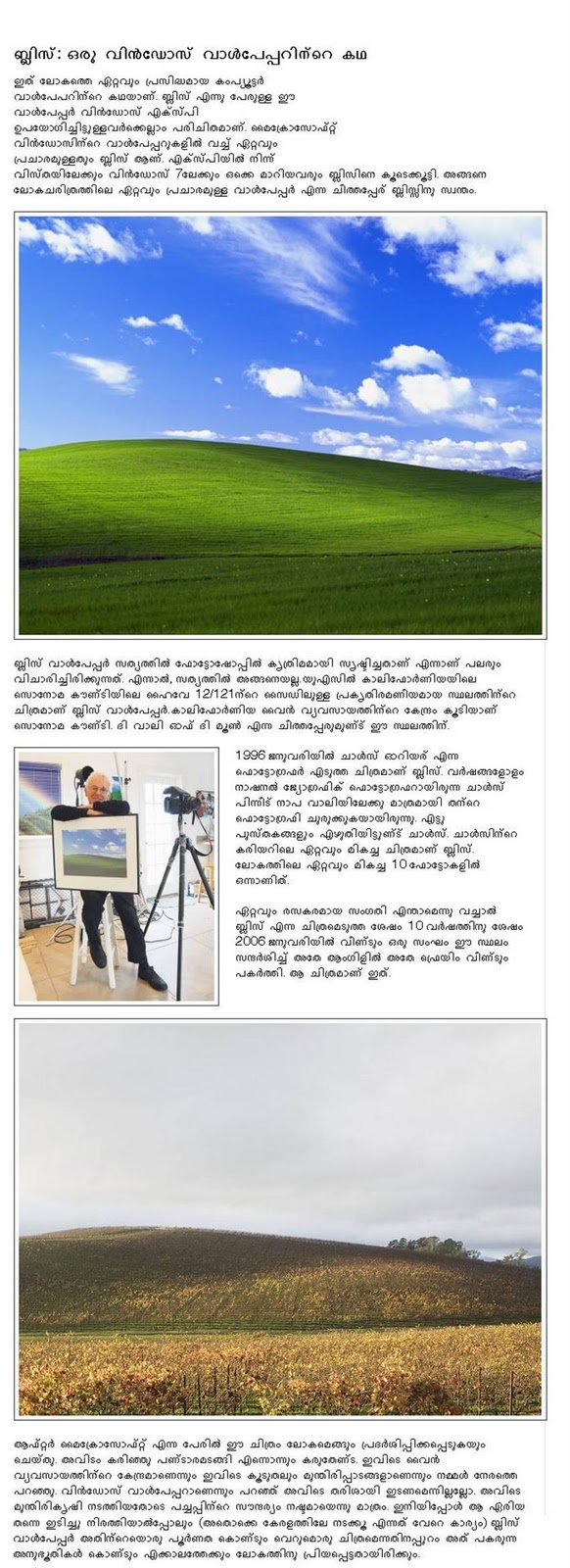--യോയോ-
സമകാലികമായ ശൈലികളില് നിന്നും ഏറെ വ്യത്യസ്തമായ ഒരു തരം ശൈലിയാണ് "യോയോ" ശൈലി.
"യോയോ"വിനെ ഒരു പ്രസ്ഥാനം, ശൈലി, സമ്പ്രദായം, സംസ്കാരം, ചിന്താധാര - എങ്ങനെ
വേണമെങ്കിലും വിശേഷിപ്പിയ്ക്കാം.
ഒരു ശരാശരി മനുഷ്യന് "യോയോ" ആയി രൂപാന്തരം പ്രാപിയ്ക്കാന് എത്രത്തോളം അധ്വാനം
ആവശ്യമുണ്ട്, എന്നതിനെക്കുറിച്ച് നടത്തിയ പഠനത്തില് നിന്നും ആവീര്ഭവിച്ച
സാമാന്യമായ മാനദണ്ഡങ്ങള് ആണ് ഇവിടെ പ്രതിപാദിയ്ക്കുന്നത്. അത്ഭുതമെന്നു
പറയട്ടെ! കുറച്ചു കാര്യങ്ങള് ശ്രദ്ധിച്ചാല് ആര്ക്കു വേണെമെങ്കിലും യോയോ ആവാം..
"യോയോ" ധാര പിന്തുടരുന്ന ഒരാള്ക്ക് മസില് കൊണ്ട് ഒന്നും ചെയ്യാനില്ല എന്നതു
വളരെ വ്യക്തമാണ്. അതു കൊണ്ടു മെലിഞ്ഞവര്ക്കും, ശോഷിച്ചവര്ക്കും ഒരു പോലെ
തിരഞ്ഞെടുക്കാവുന്ന സമ്പ്രദായം ആണ് "യോയോ".
ഭൗതികവും പ്രത്യക്ഷവുമായ രൂപത്തില് നിന്നും തുടങ്ങി "യോയോ" യുടെ സൂക്ഷ്മ
തലങ്ങളെ തെല്ലൊന്ന് വിശകലനം ചെയ്യാനുള്ള ശ്രമമാണിവിടെ. യോയോ ധാര പിന്
തുടരുന്നവര്ക്ക് ആത്മപരിശോധന നടത്തുവാനും, യോയോ ആവാന് കൊതിയ്ക്കുന്നവര്ക്ക്
ഒരു പ്രചോദനമാകാനും ഉതകട്ടെ ഈ കുറിപ്പ്..
യോയോയുടെ ശാരീരികമായ തലങ്ങളില് നിന്നു തുടങ്ങാം.
1) തലമുടി - ടൗണിലുള്ള ടിവി വെച്ച ഹെയര് ഡ്രസ്സിംഗ് സെന്ററില് നിന്നു
ഇഷ്ടമുള്ള ഡിസൈന് തിരഞ്ഞെടുക്കാം.. ടിവി സര്വ്വസാധാരണമാകുന്നതു കൊണ്ട് rate
അന്വേഷിക്കുന്നതാവും കൂടുതല് നന്നാവുക. എത്രത്തോളം പ്രാകൃതമാകുന്നുവോ അത്രയും
നന്ന്. കണ്ടാല് എല്ലാവരും "ഒന്നു" നോക്കണം. ഒരു പ്രാവിശ്യത്തില് കൂടുതല്
നോക്കുന്നുണ്ടെങ്കില് കാര്യമായി എന്തോ കുഴപ്പം സംഭവിച്ചിട്ടുണ്ടെന്നു വേണം
കരുതാന്. ബ്രില് ക്രീം വാങ്ങാന് പറ്റുന്നവര് അതു കോരിത്തേക്കുക അല്ലാത്തവര്
പച്ചവെളിച്ചെണ്ണ പൊത്തുക.
പുതിയ പുതിയ hair style കൊണ്ടു വരാന് നിരീക്ഷണപാടവം പോഷിപ്പിച്ചേ മതിയാവൂ. M-TV,
V-Channel, SS Music ഇതിലൊക്കെ വരുന്ന hip-hop ഗാനരംഗങ്ങള്
ശ്രദ്ധിച്ചുകൊണ്ടേയിരിക്കുക. പുത്തന് "യോയോ" തരംഗങ്ങളുമായി എപ്പോഴും updated
ആയിരിക്കുക.
2) മീശയും യോയോയും ഒരേ തൂവല്പക്ഷികള് അല്ല. മീശയെ സ്നേഹിക്കുന്നവര്ക്ക്
യോയോ എന്നും വെല്ലുവിളി ആണെന്നു പറയാതെ വയ്യ. മീശ ഒന്നുകില് trim ചെയ്യുക,
അല്ലെങ്കില് പൂര്ണ്ണമായും കളയുക. കട്ടി മീശയും വെച്ചുകൊണ്ട് യോയോ lookല്
നടന്നാല്, യോയോ ദൈവങ്ങള് ശപിയ്ക്കും. പിന്നെ ഒരു തിരിച്ചുവരവും ശാപമോക്ഷവും
ഒക്കെ, സമയം കുറേ പിടിയ്ക്കും..
3) താടി - ബുള്ഗാന്, ഫ്രഞ്ച് എന്നീ പഴഞ്ചന് styleല് നിന്നു മാറി
ക്രിയാത്മകമായ കൊത്തുപണികള് ഉള്ള പുതു ശൈലിയിലേക്ക് വരണം. നേരത്തെ മുടിയുടെ
കാര്യത്തില് പറഞ്ഞ - "ഒന്നു" നോക്കണം എന്ന കാര്യം ഏറെക്കുറെ എല്ലാ "യോയോ"
രീതികള്ക്കും ഉപയുക്തമാണ്.
4) കണ്ണാടി - അഥവാ glasses - "അയ്യേ.. ഇതിവനു ചേര്വോ.." എന്നു ആരും ചോദിക്കുന്ന
തരത്തിലാവണം തിരഞ്ഞെടുക്കേണ്ടത്.. ഇതില്ലെങ്കിലും "യോയോ" ആകാം എന്നുള്ളതു
കൊണ്ട് കണ്ണാടിയെ കുറിച്ചാലോചിച്ച് കൂടുതല് തല പുണ്ണാക്കേണ്ട കാര്യമില്ല.
5) തൊപ്പി - ഏതെങ്കിലും ഒരു തൊപ്പി, എന്തു രീതിയിലുള്ളതായാലും തൊപ്പിയായാല്
മതി. തൊപ്പി ഉണ്ടായേ തീരൂ..
6) ഷര്ട്ട് ഇറക്കം കുറഞ്ഞത് പകുതി ഇന്സൈഡ് - അഥവാ പകുതി ഔട്ട്സൈഡ് ചെയ്യുക.
യാതൊരു കാരണവശാലും മുഴുവനായി ഇന്സൈഡോ ഔട്ട്സൈഡോ ചെയ്യാന് പാടില്ല. മുന്
വശത്തെ പകുതിയോടൊപ്പം പുറകുവശം ലേശം ഇന് ചെയ്യാം. എന്തായാലും കാണുന്നവര്ക്ക്
ഇന്സൈഡ് ആണോ ഔട്ട്സൈഡ് ആണോ എന്നു ആശയക്കുഴപ്പം ഉണ്ടാകാന് പോന്നതാവണം. അത്രയും
ശ്രദ്ധിയ്ക്കണം.
രണ്ട് layer ആവശ്യമുള്ളവര്ക്ക് അകത്ത് teashirt ഉം, പുറത്ത് കറുപ്പ്
ജാക്കറ്റും ധരിയ്ക്കാം. തണുപ്പുള്ള നവംബര്, ഡിസംബര് മാസങ്ങളിലാണ് ഈ വേഷം
അഭികാമ്യം.
7) ഇനി പാന്റ് രണ്ടു പ്രധാന വിഭാഗങ്ങളില് നിന്നും അഭിരുചിയ്ക്കനുസരിച്ച്
യഥേഷ്ടം തിരഞ്ഞെടുക്കാം.
a) കാര്ഗോസ് - അകത്ത് അത്രക്ക് കേമമായ brand ഇല്ലാത്തവര്ക്കും, മാന്യതയുടെ
അതിര്വരമ്പുകള്ക്കകത്ത് കഴിയുന്നവര്ക്കും ഒരു പോലെ ഇഷ്ടപ്പെടുന്ന വളരെ
ഉപയോഗപ്രദമായ ഇനം പാന്റാണിത്. ചറപറാ പോക്കറ്റുക്കളും, വലിയ കാലും, ഞാന്നു
കിടക്കുന്ന കൊളുത്തും ആകെ ഒരു ആനച്ചന്തം ആണിവന്. ഇത്തിരി മെലിഞ്ഞവര്ക്ക് കേറി
ഒന്നു മിനുങ്ങാന് പറ്റുന്ന ഇനവും ഇവന് തന്നെ. ഒരു ഇരുപതു കൂട്ടം സാമാനങ്ങള്
ഇവന്റെ പോക്കറ്റുകളില് വെച്ച് അനായാസേന കൊണ്ടു പോകാം എന്ന ഒരു നേട്ടം കൂടി
ഉണ്ട് ഈ ചുള്ളന് പാന്റിന്..
b) ലോ വെയ്സ്റ്റ് - അകത്ത് കേമമായ brand ഉണ്ടെങ്കില് മാത്രം - അതിന്റെ വിശേഷം
നാട്ടുകാരെ അറിയിക്കാനും, മാന്യതയുടെ അതിര്വരമ്പുകളില് "ആണോ" "അല്ലയോ" എന്നു
നാട്ടുകാരെ ഇരുത്തി ചിന്തിപ്പിക്കാനും പോന്ന പോക്കിരി jeans ആണിവന്. മിഡി പോലെ താഴോട്ടിറക്കി, അകത്തെ ബ്രാന്ഡ് പ്രദര്ശിപ്പിച്ചു നടക്കാന് പാകത്തിനേ ഇവനെ ധരിക്കാന് പറ്റൂ. നാട്ടുകാരുടെ പ്രാര്ത്ഥനയാണോ അതോ ലോവെയിസ്റ്റിന്റെ design ആണോ ഇത് ഊരിപോകാത്തതിനുള്ള കാരണം എന്ന് വ്യക്തമായി അറിവില്ല. എന്തായാലും - ഉരിഞ്ഞു ഉരിഞ്ഞില്ല, അകത്തും brand, പുറത്തും brand എന്നതൊക്കെയാണ്
ലോവെയിസ്റ്റ് സിദ്ധാന്തങ്ങള്.
8) ഫോര്മല് ആണെന്ന് ഒരു കുഞ്ഞിനു പോലും സംശയം തോന്നാത്ത രീതിയിലുള്ള
പാദരക്ഷകള് വേണം തിരഞ്ഞെടുക്കാന്. പാദരക്ഷകള് എന്നു പറയുമ്പോള് ഷൂ എന്നു വേണം കരുതാന്. Adidas, Nike, Wu, Reebok, Woodland ഇങ്ങനെ അങ്ങോട്ട് പോകാം,
അല്ലെങ്കില് ഇത്തിരി തന്റേടവും, സാമര്ത്ഥ്യമുള്ളവര്ക്കായി "കമ്പിനി"
സാധനങ്ങള് വേറേയുണ്ട് - Adibas, Nikke, Woo, Reehok, Woodlands അങ്ങനേം പോകാം.
എന്തായാലും ഷൂ ഇല്ലാതെ "യോയോ" ആവുന്നതിനെ കുറിച്ചു സ്വപ്നം കാണുകയേ വേണ്ട..
9) വാച്ച് - ഭാരം കൂടും തോറും "യോ" കൂടിക്കൊണ്ടേ ഇരിക്കും. ഇടത്തരം ഭാരം കൊണ്ട്
തൃപ്തിപ്പെടുന്നവര് യോയോ-സാക്ഷാത്കാരം കിട്ടാതെ വെറും "യോ" ആയി ഗതി കിട്ടാതെ
അലഞ്ഞു നടന്ന്, "യ്യോ" ആയി അവസാനിച്ച ചരിത്രവും ഉണ്ട്. മറ്റെല്ലാ
വേഷവിധാനങ്ങളെയും പോലെ, "ഗഫൂര് ക ദോസ്തിന്റെ" കടയില് നിന്നും വാങ്ങാന്
പറ്റുന്ന ഇനം ഇതിലും ഉണ്ട് - സമയം അല്ല പ്രധാനം സ്റ്റൈല് ആണ്..
10) വള(ഒറ്റ കയ്യില് മാത്രം - സ്റ്റീലിന്റെ), കടുക്കന് (ഒറ്റ കാതില് മാത്രം
സ്റ്റീലിന്റെ), മാല(ചങ്ങല പോലുള്ളത് - ഒരു കഴുത്ത് മാത്രം ഉള്ളതു കൊണ്ടും, അര മാലയ്ക്ക് നിലനില്പ്പില്ലാത്തതു കൊണ്ടും ഒരു മാല പൂര്ണ്ണമായും ധരിയ്ക്കാം).
11) Headphone/Earphone - നിര്ബന്ധമായും ധരിച്ചിരിക്കണം. പാട്ടുപെട്ടി
ഇല്ലെങ്കിലും, earphone നിര്ബന്ധമായും ചെവിയിലുള്ള തുളകളില് തിരുകണം,
പാട്ടിന്റെ താളത്തില് ഇടയ്ക്ക് തല ആട്ടണം. പ്രത്യേകം ശ്രദ്ധിയ്ക്കുക
-HipHop, Rock, Pop
അല്ലാതെ വേറെ ഒരു genre പാട്ടുകള് ഇതിനകത്തു നിന്നും കേട്ടാല്, അതില്പരം
ഒരു നാണക്കേട് ഒരു "യോയോ"ക്ക് സംഭവിക്കാനില്ല. ഭക്തിഗാനവും കേട്ടു പോകുന്ന " യോയോ"വെ ആര്ക്കെങ്കിലും ഉള്ക്കൊള്ളാന് പറ്റുമോ?
സാധാരണക്കാരനായ "യോയോ" ആയാല് മതിയെങ്കില് ഇത്രയും കൊണ്ട് അവസാനിപ്പിക്കാം.
ഇത്തിരി കടുത്ത "യോയോ" ആവണമെങ്കില്, ശരീരത്തില് ആസകലം തുളകളിട്ടു അവിടെയൊക്കെ
സ്റ്റീല് കൊളുത്തുകള് ഞാത്തിയിട്ടു നടക്കാം.
ഇത്രയുമായപ്പോള് ഭൗതികമായ വശങ്ങള് ഏറെക്കുറേ പൂര്ത്തിയായെന്നു പറയാം. പക്ഷെ" യോയോ" അടുക്കും തോറും ആഴം കൂടി വരുന്ന സാഗരം ആണ്, ഒരു മിടുക്കന് യോയോ ഭാഷാപരവും വാചികവുമായ ആയ ചില പ്രയോഗങ്ങള് കൂടി സ്വായത്തമാക്കേണ്ടതുണ്ട്.
അടിസ്ഥാനപരമായുള്ള നിയമം - വാക്യങ്ങള് വെട്ടി ചുരുക്കുക എന്നതു തന്നെ ആണ്.
പിന്നെ അല്പം രൂപാന്തരങ്ങളും, കേള്വിക്കാരെ കോരിത്തരിപ്പിക്കുന്ന - ഇവന് കൊള്ളാലോ - എന്നു തോന്നിപ്പിക്കുന്ന പ്രയോഗങ്ങളും..
ഒരു യോയോ മനുഷ്യന് എഴുതുമ്പോള് ഒരൊ വാക്കിലും യോയോ ശൈലി തുളുമ്പി നില്ക്കണം.
വാക്കുകളിലെ അക്ഷരങ്ങള് വെട്ടിച്ചുരുക്കുന്നതോടൊപ്പം താഴെ പറഞ്ഞതു പോലുള്ള ചില
പരിണാമങ്ങളും അത്യന്താപേക്ഷിതമാണ്:-
1) my = ma (ഉദാ: my pen മറന്നേക്കൂ ഇനി മുതല് ma pen)
2) s = z (s ന്റെ ഉപയോഗം പരമാവധി കുറയ്ക്കുക, z ന്റെ ഉപയോഗം പരമാവധി കൂട്ടുക.
ഉദാ: becoz, wazz up, itz)
3) Yes = Yep, Yeah, Yo അല്ലെങ്കില് Yup
4) OK = K
5) No = Nope (കോപ്പ് ഇടയ്ക്കു പ്രയോഗിച്ചേ മതിയാവൂ)
6) want to = wanna
7) going to = gonna
8) ഡാ ചെക്കാ = Hi dude, Hey dude
9) girls = gals
10) then = den
11) there = der
12) the = d
13) are = r
14) I am = am
15) to = 2
ഇനി സന്ദര്ഭോചിതമായി ഉപയോഗിയ്ക്കാന് പറ്റുന്ന ചില വാക്കുകളും, ശബ്ദങ്ങളും:-
1) ഒരു ഗ്യാപ് കിട്ടുമ്പോള് cool എന്നു പറയണം, എത്ര hot ആണെങ്കിലും.
2) അബദ്ധം പറ്റുമ്പോള്, oops എന്നും, Oh! എന്നും.. പിന്നെ സ്വന്തമായി ചില
പരീക്ഷണശബ്ദങ്ങള് - ഓവര് ആക്കാതെ പ്രയോഗിയ്ക്കുകയും ആവാം..
3) ആശ്ചര്യപ്പെടുമ്പോള്, WOW, OMG, Ah, Oh, huh, uh.. എന്നും.
4) നിര്വികാരത കാണിയ്ക്കാന് mm, hmm എന്നൊക്കെ ഇടയ്ക്കു പറയണം.
5) അതൃപ്തി കാണിക്കാനായി, what the hell (WTH) ഉം ഇത്തിരി കടുത്ത പ്രയോഗമായ ഉം പ്രയോഗിയ്ക്കാം.
എല്ലാ പ്രമുഖ സോഷ്യല് നെറ്റ്വര്ക്കുകളിലും ഒരു account, ചേതന് ഭഗതിന്റെ
പുസ്തകങ്ങളോട് തീക്ഷ്ണമായ ഒരു ആരാധന(5 point someone, 3 mistakes of my life
ഇതു രണ്ടും വായിച്ചിട്ടൂണ്ടെന്ന് എല്ലാവരും അറിയണം). ഇതൊക്കെ ഒരു discussion
ഉണ്ടാകുമ്പോള് മറ്റ് "യോയോ"കളുടെ ഇടയില് പിടിച്ചു നില്ക്കാന് ഗുണം ചെയ്യും..!!!





















